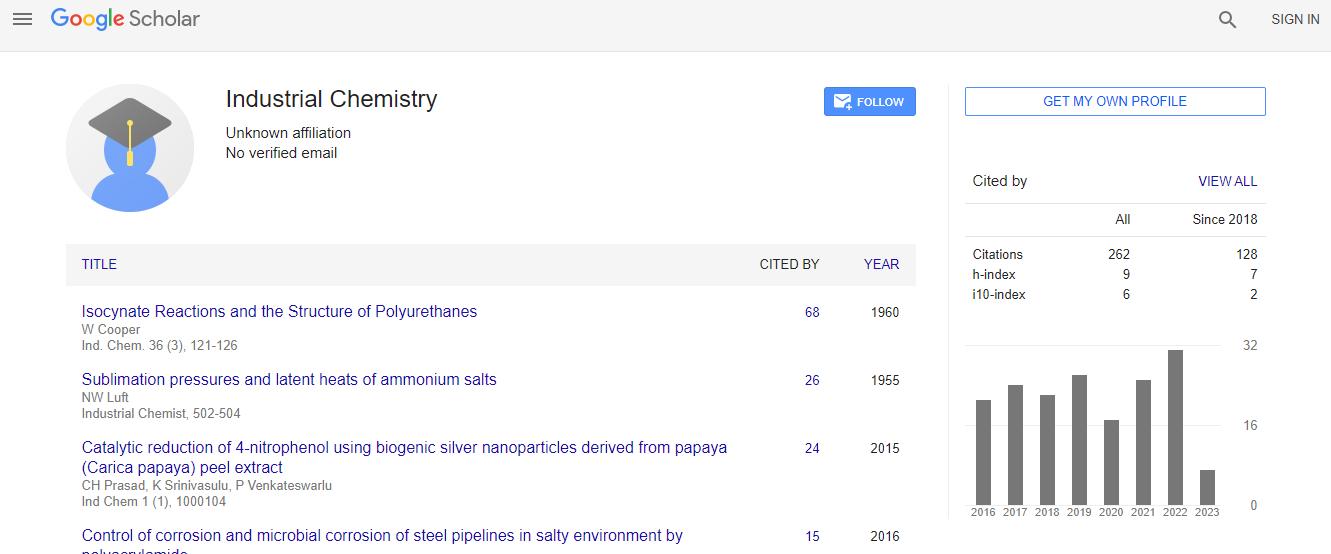Our Group organises 3000+ Global Conferenceseries Events every year across USA, Europe & Asia with support from 1000 more scientific Societies and Publishes 700+ Open Access Journals which contains over 50000 eminent personalities, reputed scientists as editorial board members.
Open Access Journals gaining more Readers and Citations
700 Journals and 15,000,000 Readers Each Journal is getting 25,000+ Readers
Google Scholar citation report
Citations : 262
Industrial Chemistry received 262 citations as per Google Scholar report
Indexed In
- Index Copernicus
- Google Scholar
- RefSeek
- Directory of Research Journal Indexing (DRJI)
- Hamdard University
- EBSCO A-Z
- OCLC- WorldCat
- Scholarsteer
- Geneva Foundation for Medical Education and Research
- Euro Pub
Useful Links
Recommended Journals
Related Subjects
Share This Page
Chemoenzymatic synthesis of polysaccharide-grafted polymeric materials
2nd World Conference on Industrial Chemistry and Water Treatment
Jun-Ichi Kadokawa
Kagoshima University, Japan
Keynote: Ind Chem
Abstract
Biological macromolecules, such as polysaccharide and protein (peptide), are vital materials in living systems. Such functions are appeared by their controlled primary and higher-ordered structures. Furthermore, branched or grafted biological polymers are often appeared in nature and such complicated structures contribute to exhibiting important in vivo functions. Accordingly, synthetic method for combining several biological macromolecules into branching or grafting is expected to produce new functional polymers. On the basis of the viewpoint, we have reported the synthesis of amylose-grafted polymeric materials by chemoenzymatic approach, which is a combined method of phosphorylase, catalyzed enzymatic polymerization of �?±-D-glucose 1-phosphate (G-1-P) monomer for the amylose production with appropriate chemical reactions. The phosphorylase-catalyzed enzymatic polymerization using G-1-P as a monomer proceeds with the construction of ï¡-glycosidic bond under mild conditions, leading to the direct formation of �?±(1�?³4)-glucan chain, i.e., amylose, in the aqueous media. To initiate the polymerization, a maltooligosaccharide is required as a primer in the initial reaction media. The synthesis of amylosegrafted heteropolysaccharides has been performed by combining the phosphorylase-catalyzed enzymatic polymerization with the appropriate chemical reaction (chemoenzymatic method). For example, amylose-grafted carboxymethyl cellulose (CMC) was synthesized as the following chemoenzymatic method. A maltooligosaccharide having an amino group was first introduced to the CMC by using condensing agent. Then, the phosphorylase-catalyzed enzymatic polymerization of G-1-P from the maltooligosaccharide chain ends on the product was performed to obtain the desired amylose-grafted CMC. The product had the rigid CMC main chain, which further assembled, leading to nanofibers by the formation of double helix between the long amylose graft chains in the intermolecular CMC chains. The chemoenzymatic synthesis of amylose-grafted poly �?³-glutamic acid (PGA) as a new artificial polysaccharide-polypeptide conjugate was also investigated. The product formed a robust hydrogel, which could be converted into a regularly controlled porous material.Biography
Jun-Ichi Kadokawa holds PhD degree in Engineering. Currently, he is a Professor of Chemistry, Biotechnology and Chemical Engineering at Kagoshima University, Japan. He studied applied chemistry and materials chemistry at Tohoku University, where he received his MS degree in 1989 and PhD in 1992. He has then joined Yamagata University as a Research Associate. From 1996 to 1997, he has worked as a Visiting Scientist at the Max-Planck-Institute for Polymer Research in Germany. In 1999, he became an Associate Professor at Yamagata University and moved to Tohoku University in 2002. He was appointed as a Professor of Kagoshima University in 2004. His research interests focus on enzymatic synthesis of functional oligo- and polysaccharides and control of their higher-ordered structures. He has received the award for Encouragement of Research in Polymer Science (1997) and the Cellulose Society of Japan award (2009).

 Spanish
Spanish  Chinese
Chinese  Russian
Russian  German
German  French
French  Japanese
Japanese  Portuguese
Portuguese  Hindi
Hindi 